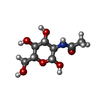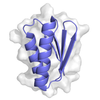[English] 日本語
 Yorodumi
Yorodumi- PDB-9b7g: Cryo-EM structure of antibody TJ5-13 bound to H3 COBRA NG2 hemagg... -
+ Open data
Open data
- Basic information
Basic information
| Entry | Database: PDB / ID: 9b7g | ||||||||||||||||||||||||||||||
|---|---|---|---|---|---|---|---|---|---|---|---|---|---|---|---|---|---|---|---|---|---|---|---|---|---|---|---|---|---|---|---|
| Title | Cryo-EM structure of antibody TJ5-13 bound to H3 COBRA NG2 hemagglutinin | ||||||||||||||||||||||||||||||
 Components Components |
| ||||||||||||||||||||||||||||||
 Keywords Keywords | VIRAL PROTEIN / hemagglutinin / antigen / antibody / Fab | ||||||||||||||||||||||||||||||
| Function / homology |  Function and homology information Function and homology informationviral budding from plasma membrane / clathrin-dependent endocytosis of virus by host cell / host cell surface receptor binding / fusion of virus membrane with host plasma membrane / fusion of virus membrane with host endosome membrane / viral envelope / virion attachment to host cell / host cell plasma membrane / virion membrane / membrane Similarity search - Function | ||||||||||||||||||||||||||||||
| Biological species |   Influenza A virus Influenza A virus Homo sapiens (human) Homo sapiens (human) | ||||||||||||||||||||||||||||||
| Method | ELECTRON MICROSCOPY / single particle reconstruction / cryo EM / Resolution: 2.61 Å | ||||||||||||||||||||||||||||||
 Authors Authors | Dzimianski, J.V. / Cruz, J.M. / Serrao, V.H.B. / DuBois, R.M. | ||||||||||||||||||||||||||||||
| Funding support |  United States, 1items United States, 1items
| ||||||||||||||||||||||||||||||
 Citation Citation |  Journal: J Virol / Year: 2025 Journal: J Virol / Year: 2025Title: Assessing the structural boundaries of broadly reactive antibody interactions with diverse H3 influenza hemagglutinin proteins. Authors: John V Dzimianski / Kaito A Nagashima / Joseph M Cruz / Giuseppe A Sautto / Sara M O'Rourke / Vitor H B Serrão / Ted M Ross / Jarrod J Mousa / Rebecca M DuBois /  Abstract: Influenza virus infections are an ongoing seasonal disease burden and a persistent pandemic threat. Formulating successful vaccines remains a challenge due to accumulating mutations in circulating ...Influenza virus infections are an ongoing seasonal disease burden and a persistent pandemic threat. Formulating successful vaccines remains a challenge due to accumulating mutations in circulating strains, necessitating the development of innovative strategies to combat present and future viruses. One promising strategy for attaining greater vaccine effectiveness and longer-lasting protection is the use of computationally optimized broadly reactive antigens (COBRAs). The COBRA approach involves antigen design by generating iterative, layered consensus sequences based on current and historic viruses. Antigens designed by this process show a greater breadth of antibody-mediated protection compared to wild-type antigens, with effectiveness that often extends beyond the sequence design space of the COBRA. In particular, the use of COBRA hemagglutinin (HA) proteins has led to the discovery of broadly reactive antibodies that are suggestive of their therapeutic potential. Understanding the extent to which these antibodies are effective is key to assessing the resilience of vaccine-induced immunity to diverging influenza strains. To investigate this, we tested the binding of broadly reactive antibodies with a diverse panel of H3 HA proteins. Using cryo-electron microscopy, we defined the molecular characteristics of binding for these antibodies at the paratope-epitope interface. Through sequence and structural comparisons, we observed the correlative patterns between antibody affinity and antigen structure. These data shed light on the breadth and limitations of broadly reactive antibody responses in the context of an ever-changing landscape of influenza virus strains, yielding insights into strategies for universal vaccine design.IMPORTANCEFormulating effective influenza vaccines remains a challenge due to a constantly changing landscape of circulating viruses. This is particularly true for H3N2 viruses that undergo a high degree of antigenic drift. Several new vaccine designs can elicit broadly neutralizing antibodies that are effective against a range of influenza strains. More insight is needed, however, into how resilient these antibodies will be to future strains that evolve in the context of this selective pressure. Here, we measured the precise binding characteristics of three broadly neutralizing antibodies to 18 different hemagglutinin (HA) proteins representing almost 50 years of virus evolution. Using single-particle cryo-electron microscopy and X-ray crystallography, we determined the structural characteristics of the epitopes bound by these antibodies and identified specific amino acids that greatly impact the effectiveness of these antibodies. This provides important insights into the longevity of antibody efficacy that can help guide design choices in next-generation vaccines. | ||||||||||||||||||||||||||||||
| History |
|
- Structure visualization
Structure visualization
| Structure viewer | Molecule:  Molmil Molmil Jmol/JSmol Jmol/JSmol |
|---|
- Downloads & links
Downloads & links
- Download
Download
| PDBx/mmCIF format |  9b7g.cif.gz 9b7g.cif.gz | 374 KB | Display |  PDBx/mmCIF format PDBx/mmCIF format |
|---|---|---|---|---|
| PDB format |  pdb9b7g.ent.gz pdb9b7g.ent.gz | 288 KB | Display |  PDB format PDB format |
| PDBx/mmJSON format |  9b7g.json.gz 9b7g.json.gz | Tree view |  PDBx/mmJSON format PDBx/mmJSON format | |
| Others |  Other downloads Other downloads |
-Validation report
| Summary document |  9b7g_validation.pdf.gz 9b7g_validation.pdf.gz | 2.1 MB | Display |  wwPDB validaton report wwPDB validaton report |
|---|---|---|---|---|
| Full document |  9b7g_full_validation.pdf.gz 9b7g_full_validation.pdf.gz | 2.1 MB | Display | |
| Data in XML |  9b7g_validation.xml.gz 9b7g_validation.xml.gz | 66.2 KB | Display | |
| Data in CIF |  9b7g_validation.cif.gz 9b7g_validation.cif.gz | 97.3 KB | Display | |
| Arichive directory |  https://data.pdbj.org/pub/pdb/validation_reports/b7/9b7g https://data.pdbj.org/pub/pdb/validation_reports/b7/9b7g ftp://data.pdbj.org/pub/pdb/validation_reports/b7/9b7g ftp://data.pdbj.org/pub/pdb/validation_reports/b7/9b7g | HTTPS FTP |
-Related structure data
| Related structure data |  44305MC  9b7hC  9b7iC M: map data used to model this data C: citing same article ( |
|---|---|
| Similar structure data | Similarity search - Function & homology  F&H Search F&H Search |
- Links
Links
- Assembly
Assembly
| Deposited unit | 
|
|---|---|
| 1 |
|
- Components
Components
-Protein , 1 types, 3 molecules ABC
| #1: Protein | Mass: 62717.137 Da / Num. of mol.: 3 Source method: isolated from a genetically manipulated source Source: (gene. exp.)   Influenza A virus / Gene: HA / Production host: Influenza A virus / Gene: HA / Production host:  |
|---|
-Antibody , 2 types, 6 molecules HJQLKP
| #2: Antibody | Mass: 25796.775 Da / Num. of mol.: 3 Source method: isolated from a genetically manipulated source Source: (gene. exp.)  Homo sapiens (human) / Production host: Homo sapiens (human) / Production host:  #3: Antibody | Mass: 22762.055 Da / Num. of mol.: 3 Source method: isolated from a genetically manipulated source Source: (gene. exp.)  Homo sapiens (human) / Production host: Homo sapiens (human) / Production host:  |
|---|
-Sugars , 5 types, 21 molecules 
| #4: Polysaccharide | Source method: isolated from a genetically manipulated source #5: Polysaccharide | Source method: isolated from a genetically manipulated source #6: Polysaccharide | Source method: isolated from a genetically manipulated source #7: Polysaccharide | Source method: isolated from a genetically manipulated source #8: Sugar | ChemComp-NAG / |
|---|
-Details
| Has ligand of interest | N |
|---|---|
| Has protein modification | Y |
-Experimental details
-Experiment
| Experiment | Method: ELECTRON MICROSCOPY |
|---|---|
| EM experiment | Aggregation state: PARTICLE / 3D reconstruction method: single particle reconstruction |
- Sample preparation
Sample preparation
| Component | Name: A complex of TJ5-13 Fab bound to the H3 COBRA NG2 / Type: COMPLEX / Entity ID: #1-#3 / Source: RECOMBINANT |
|---|---|
| Source (natural) | Organism:  Homo sapiens (human) Homo sapiens (human) |
| Source (recombinant) | Organism:  |
| Buffer solution | pH: 7.5 |
| Specimen | Embedding applied: NO / Shadowing applied: NO / Staining applied: NO / Vitrification applied: YES |
| Specimen support | Grid material: COPPER / Grid mesh size: 400 divisions/in. / Grid type: Quantifoil R1.2/1.3 |
| Vitrification | Instrument: FEI VITROBOT MARK IV / Cryogen name: ETHANE / Humidity: 100 % / Chamber temperature: 298 K |
- Electron microscopy imaging
Electron microscopy imaging
| Experimental equipment |  Model: Titan Krios / Image courtesy: FEI Company |
|---|---|
| Microscopy | Model: FEI TITAN KRIOS |
| Electron gun | Electron source:  FIELD EMISSION GUN / Accelerating voltage: 300 kV / Illumination mode: FLOOD BEAM FIELD EMISSION GUN / Accelerating voltage: 300 kV / Illumination mode: FLOOD BEAM |
| Electron lens | Mode: BRIGHT FIELD / Nominal defocus max: 2100 nm / Nominal defocus min: 500 nm |
| Image recording | Electron dose: 45.8 e/Å2 / Film or detector model: GATAN K3 BIOQUANTUM (6k x 4k) / Num. of grids imaged: 2 / Num. of real images: 13223 |
| EM imaging optics | Energyfilter name: GIF Bioquantum / Energyfilter slit width: 20 eV |
- Processing
Processing
| EM software |
| ||||||||||||||||||||||||||||||||||||||||||||
|---|---|---|---|---|---|---|---|---|---|---|---|---|---|---|---|---|---|---|---|---|---|---|---|---|---|---|---|---|---|---|---|---|---|---|---|---|---|---|---|---|---|---|---|---|---|
| CTF correction | Type: PHASE FLIPPING AND AMPLITUDE CORRECTION | ||||||||||||||||||||||||||||||||||||||||||||
| Particle selection | Num. of particles selected: 3186155 | ||||||||||||||||||||||||||||||||||||||||||||
| Symmetry | Point symmetry: C3 (3 fold cyclic) | ||||||||||||||||||||||||||||||||||||||||||||
| 3D reconstruction | Resolution: 2.61 Å / Resolution method: FSC 0.143 CUT-OFF / Num. of particles: 70400 / Symmetry type: POINT | ||||||||||||||||||||||||||||||||||||||||||||
| Atomic model building | B value: 63 / Protocol: AB INITIO MODEL / Space: REAL | ||||||||||||||||||||||||||||||||||||||||||||
| Atomic model building |
| ||||||||||||||||||||||||||||||||||||||||||||
| Refine LS restraints |
|
 Movie
Movie Controller
Controller


 PDBj
PDBj








